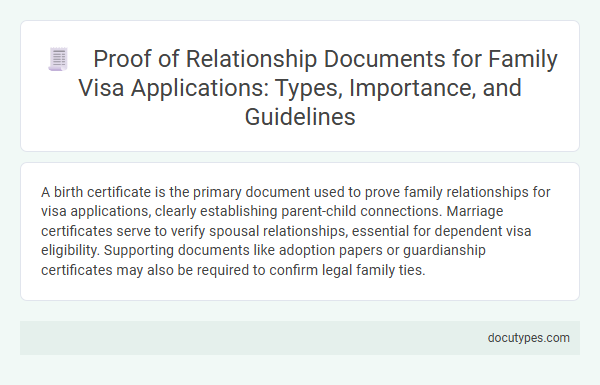A birth certificate is the primary document used to prove family relationships for visa applications, clearly establishing parent-child connections. Marriage certificates serve to verify spousal relationships, essential for dependent visa eligibility. Supporting documents like adoption papers or guardianship certificates may also be required to confirm legal family ties.
Understanding Proof of Relationship in Family Visa Applications
| Document Type | Description | Purpose |
|---|---|---|
| Marriage Certificate | Official government-issued certificate confirming legal marriage status. | Proves spousal relationship for family visa applications. |
| Birth Certificate | Government-issued document showing the birth details of an individual. | Establishes parent-child relationship for dependent visas. |
| Adoption Papers | Legal documents certifying the adoption of a child by the visa applicant. | Validates adoptive parent-child relationships. |
| Proof of Shared Residence | Joint lease agreements, utility bills, or official correspondence showing same residential address. | Supports claims of cohabitation in partner or dependent visa cases. |
| Photos and Communication Records | Photographs together and documented communication like emails or call logs. | Provides supplementary evidence of genuine and ongoing relationships. |
| DNA Test Results | Laboratory-certified genetic testing reports. | Used to confirm biological relationships when other documents are unavailable. |
Essential Types of Relationship Documents
Essential types of relationship documents serve as proof for family visa applications. These documents verify your familial connection to the sponsor and are crucial for approval.
Common relationship documents include marriage certificates, birth certificates, and adoption papers. Certified copies or official translations may be required for submission. Providing clear and authentic documentation ensures a smoother visa process for your family.
Importance of Accurate Documentation
Proof of relationship documents are crucial for family visa applications to verify genuine family ties. Accurate documentation ensures the visa process is smooth and minimizes the risk of delays or denials.
- Marriage Certificate - Official marriage certificates validate spousal relationships for visa approval.
- Birth Certificates - Birth certificates establish parent-child relationships crucial for dependent family visas.
- Adoption Papers - Legal adoption documents prove family bonds recognized by immigration authorities.
Submitting precise and authenticated documents significantly increases the likelihood of a successful family visa application.
Guidelines for Submitting Proof of Relationship
Proof of relationship is essential for family visa applications to verify the legitimate family bond between the applicant and the sponsor. Accurate submission of these documents ensures smooth visa processing and reduces the risk of application denial.
- Official Documents - Marriage certificates, birth certificates, and adoption papers serve as primary proof of familial relationships.
- Certification and Translation - All submitted documents must be certified copies and, if not in the official language, accompanied by certified translations.
- Consistency and Authenticity - Documents should be consistent with personal information in the visa application and authenticated by relevant authorities to avoid rejection.
Commonly Accepted Relationship Documents
Commonly accepted relationship documents for family visa applications include marriage certificates, birth certificates, and adoption records. These documents serve as official proof of familial ties, verifying the relationship between the applicant and the sponsor. Consular authorities often require certified copies or authenticated versions to ensure validity during the visa approval process.
Tips for Authenticating Family Documents
Proof of relationship is essential for family visa applications to verify genuine family ties. Authenticating family documents ensures smoother visa processing and reduces the risk of application rejection.
- Certified Copies - Use certified copies of birth certificates, marriage certificates, or adoption papers as official proof for relationship verification.
- Notarization - Have all family documents notarized by a recognized authority to confirm their authenticity and legal standing.
- Translation and Apostille - Translate non-English documents by a certified translator and obtain an apostille stamp if required by the visa-issuing country.
Addressing Challenges in Relationship Proof Submission
For family visa applications, a legally recognized document such as a marriage certificate or birth certificate serves as primary proof of relationship. Addressing challenges in submitting these proofs requires ensuring that documents are officially translated and notarized if issued in a foreign language. You should also prepare additional evidence like joint bank statements or photos to support the authenticity of your relationship.
Document Translation and Certification Requirements
Proof of relationship for family visa applications typically includes birth certificates, marriage certificates, or adoption papers. Accurate document translation and certification are crucial to verify these relationships for immigration authorities.
Translations must be completed by a certified translator and accompanied by an official certification or notarization. Your original documents and their certified translations ensure a smooth visa application process without delays.
Avoiding Common Mistakes in Document Preparation
What document serves as proof of relationship for family visa applications? A birth certificate or marriage certificate typically serves as the primary proof of relationship. Avoid common mistakes by ensuring these documents are original, properly translated, and officially certified to meet embassy requirements.
What Document Serves as Proof of Relationship for Family Visa Applications? Infographic

